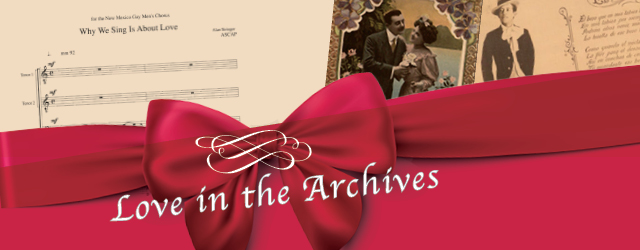-

3D Printing
UNM Digital Initiatives & Scholarly Communication
Exhibit visitors enjoyed the demonstration of our MOD-t, an affordable, easy-to-use 3D printer that heats polylactic acid (PLA) filament to create real objects from three-dimensional designs. PLA is a biodegradable polyester created sustainably from plants like corn, cassava, or sugarcane. Many other 3D printers are available and 3D printing is becoming popular with hobbyists. Industries use 3D printing to quickly prototype new products; 3D printing technology also has many potential applications in medicine.
You can use software like Maya, Sketchup, or Blender to create your own designs. People share 3D printer files on sites like Thingiverse and Pinshape, so you can print other people’s designs too. During the exhibit, several simple love-related designs were printed for visitors to take with them.
Curated by Amy Winter, Program Specialist, Digital Initiatives and Scholarly Communication
-

Ephemera
UNM Center for Southwest Research
Spanish letter of devotion, Santa Fe, April 19, 1859, from Jose Maria Sanchez to his wife Dona Paula Sena, original letter, with transcription and translation by Sonia Balasch and Aaron Taylor. Felipe Chaves Papers, MSS 10 BC, Box 1, Folder 66.
Susan B. Anthony 55th Anniversary Program, February 15, 1905, Albuquerque. The scrapbook has clippings and mementos kept by Kent, who organized and attended many social events in the Albuquerque area from 1881-1918. Margaret Kent Medler scrapbook, MSS 225 BC, Box 1.
Curated by Nancy Brown-Martinez, Archivist, Center for Southwest Research
-

Love in Song
Center for Southwest Research
Materials from two collections were displayed.
The Latin American Sheet Music Collection, MSS 932 BC, 1835-1996, contains many illustrated scores which have the composers’ photographs and signatures. There are songs from Argentina, Brazil, Chile, Colombia, Costa Rica, Cuba, the Dominican Republic, Mexico, Paraguay, Puerto Rico, and Uruguay, as well as Spain, Portugal, Denmark, France, Germany, Italy, and the United States. The largest component is from Mexico. The musical range represented includes popular and classical music with boleros, tangos, marches, waltzes, corridos, rancheras, fox trot and regional canciones. The majority of the texts are popular and classical sheet music that belong to the 20th century. Musicians represented include Agustin Lara and Maria Teresa, Astor Piazzolla, Ernesto Lecuona, Maria Alma, Miguel Bernal Jimenez, Manuel de Falla and many others.
The Bruce T. Ellis Sheet Music Collection contains approximately 600 scores, many first editions, dating from 1818-1945. Many covers are illustrated with beautiful art works. There are American as well as foreign composers. Among them are various dances, such as polkas, waltzes, can-cans, quadrilles, mazurkas, schottisches, cake-walks, lancers, gavotte, galop, quick-steps, etc. Others are ballads, opera songs, concert hall songs, show songs and Sousa marches. One group has songs by African American minstrel groups. Also included are women’s temperance pieces, American political and patriotic songs, and death dirges. There are military songs from the Civil War, Mexican American War, Spanish American War and World War I.
Curated by Nancy Brown-Martinez, Archivist, Center for Southwest Research
-

Mexican Romantic Postcards
Center for Southwest Research
This collection of “cartulinas de amor” represents a little studied aspect of post-revolutionary Mexican culture and middle class ideals. These images and texts show the intimate part of society, the changing mores, views of family, home and society. The collection affords the opportunity to view many disciplines, including portrait photography, art, intimacy, love, courtship, family, family relationships, class and gender.
The collection consists of postcards that date from 1908 to the 1940s with the majority in the teens, 1920s and 1930s. Most are photographic portraits of anonymous subjects, while others feature songs, poems, or portraits of celebrities such as Lupe Rivas Cacho, Felipe Llera, Esteher Tapia, Ernesto Rubio, and others. Many have handwritten messages on the verso. Most were produced and circulated in Mexico, with a few that were printed and circulated in other countries (e.g. Colombia, Spain, Portugal). Some postcards contain interventions of artwork.
Our entire Mexican Romantic Postcard Collection is available in digital format from New Mexico's Digital Collections!
Curated by Wendy Pedersen, Center for Southwest Research.
-

New Mexico Composers Archive
UNM Digital Initiatives & Scholarly Communication
Merging the digital with the physical, the New Mexico Composers' Archive (MSS 904 BC) was featured on screen and in print during Love in the Archives. Begun in 1973 by then-Dean of Libraries Dr. John Harvey, the collection has been partially digitized. Exhibit-goers were able to interact with the digital and physical objects and draw their own conclusions about the pros and cons of each format. A few pieces were newly digitized for the exhibit and they are included here.
Curated by Amy Winter, Program Specialist, Digital Initiatives and Scholarly Communication
-

Outlaws in Love
Center for Southwest Research
Brazilian folk literature has long been a focus of curators of UNM’s Latin American Collections. While thinking about materials for this event, yet another shipment of Literatura de Cordel came across my desk and it included a piece on Brazil’s favorite outlaw couple, Maria Bonita and Lampião.
Lampião (Virgulino Ferreira da Silva, 1897-1938) was a notorious bandit (cangaceiro) active in the 1920s and 1930 in Brazil’s hardscrabble Northeast. His reputation as a folk hero is somewhere between those of Pancho Villa, Billy the Kid, and Robin Hood. His relationship with Maria Bonita is romanticized with the same flavor as fans in the US view the violent and dramatic exploits of Bonnie and Clyde.
Maria Bonita (Maria Déia, 1911-1938) joined the band in 1930 and became Lampião’s common-law wife, although she was married but estranged from her husband. Cangaceiro women were well-armed and were trained in the use of weapons. Females whose partners were killed had to either take up with another band member or face execution, as they were considered a liability if captured. Several women joined the band and participated over the years.
Footage of daily life in the camp can be viewed at https://youtu.be/j2JNhBaFNXs
Lampião, Maria Bonita, along with 9 others of the band died via betrayal and ambush in 1938. As a grisly show of power, the paramilitary police displayed their severed heads to the public. Their remains were not released to the family for burial until 1969.
Curated by Wendy Pedersen, Center for Southwest Research
-

Posada Prints
UNM Center for Southwest Research
These four examples of broadsides (fliers sold for a few pennies) from Mexico (Mexico City, c. 1888-1920) are typical of their genre. They present poems and songs (sometime ballads known as corridos) about love -- a lover's dance, love of one's mother, secret love -- with passion and a bit of humor.
Curated by Cindy Abel Morris, Pictorial Archivist at CSWR
-

Wedding Photographs
UNM Center for Southwest Research
Representing each decade from the late 19th to the early 21st centuries, CSWR has many identified (and unidentified) photographs of people demonstrating their love through marriage. At this point, our depictions are a narrow range of traditional views--brides, grooms, and wedding party configurations. However, we continue to build our collections and welcome images that would expand our definitions of love, marriage, weddings, etc.
Curated by Cindy Abel Morris, Pictorial Archivist at CSWR
For Valentine's Day 2019, archivists from the Center for Southwest Research combined archival materials, hands-on activities, technology demonstrations, prizes, sweets and music into an engaging celebration of love in all its forms.
Event publicity materials by Patricia Campbell, Marketing Manager.
Printing is not supported at the primary Gallery Thumbnail page. Please first navigate to a specific Image before printing.




